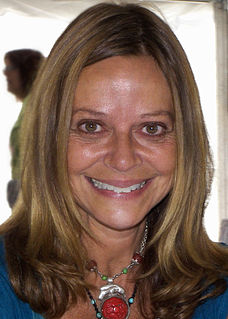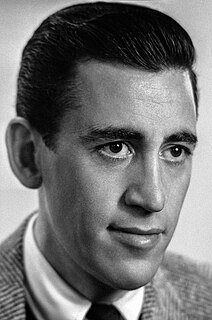Related Research Articles

My Foolish Heart is a 1949 American romantic drama film directed by Mark Robson, starring Dana Andrews and Susan Hayward. It relates the story of a woman's reflections on the bad turns her life has taken.

The Catcher in the Rye is an American novel by J. D. Salinger that was partially published in serial form from 1945–46 before being novelized in 1951. Originally intended for adults, it is often read by adolescents for its themes of angst and alienation, and as a critique of superficiality in society. The novel also deals with complex issues of innocence, identity, belonging, loss, connection, sex, and depression. The main character, Holden Caulfield, has become an icon for teenage rebellion. Caulfield, nearly of age, gives his opinion on just about everything as he narrates his recent life events.

Daphne Joyce Maynard is an American novelist and journalist. She began her career in journalism in the 1970s, writing for several publications, most notably Seventeen magazine and The New York Times. Maynard contributed to Mademoiselle and Harrowsmith magazines in the 1980s, while also beginning a career as a novelist with the publication of her first novel, Baby Love (1981). Her second novel, To Die For (1992), drew from the Pamela Smart murder case and was adapted into the 1995 film of the same name. Maynard received significant media attention in 1998 with the publication of her memoir At Home in the World, which deals with her affair with J. D. Salinger.

Holden Caulfield is a fictional character in the works of author J. D. Salinger. He's most famous for his appearance as the lead character and narrator of the 1951 novel The Catcher in the Rye. Since the book's publication, Holden has become an icon for teenage rebellion and angst, and is considered among the most important characters of 20th-century American literature. The name Holden Caulfield was initially used in an unpublished short story written in 1941 and first appeared in print in 1945.
"A Perfect Day for Bananafish" is a short story by J. D. Salinger, originally published in the January 31, 1948, issue of The New Yorker. It was anthologized in 1949's 55 Short Stories from the New Yorker, as well as in Salinger's 1953 collection, Nine Stories. The story is an enigmatic examination of a young married couple, Muriel and Seymour Glass, while on vacation in Florida. It is the first of his stories to feature a member of the fictional Glass family.

Franny and Zooey is a book by American author J. D. Salinger which comprises his short story "Franny" and novella Zooey. The two works were published together as a book in 1961, having originally appeared in The New Yorker in 1955 and 1957 respectively. The book focuses on siblings Franny and Zooey, the two youngest members of the Glass family, which was a frequent focus of Salinger's writings.

"For Esmé—with Love and Squalor" is a short story by J. D. Salinger. It recounts a sergeant's meeting with a young girl before being sent into combat in World War II. Originally published in The New Yorker on April 8, 1950, it was anthologized in Salinger's Nine Stories two years later.
"The Ocean Full of Bowling Balls" is an unpublished work by J. D. Salinger. It is about the death of Kenneth Caulfield, who later became the character Allie in The Catcher in the Rye.
"Down at the Dinghy" is a short story by J. D. Salinger, originally published in Harper's in April 1949, and included in the compilation, Nine Stories.

Shoeless Joe is a 1982 magic realist novel by Canadian author W. P. Kinsella that was later adapted into the 1989 film Field of Dreams, which was nominated for three Academy Awards.
"Teddy" is a short story by J. D. Salinger, completed on November 22, 1952, and originally published in the January 31, 1953, issue of The New Yorker. Under the influence of The Gospel of Sri Ramakrishna, Salinger created an engaging child character, Teddy McArdle, to introduce to his readership some of the basic concepts of Zen enlightenment and Vedanta reincarnation – a task that Salinger recognized would require overcoming some 1950s American cultural chauvinism.
"A Boy in France" is a short story by J. D. Salinger. It is the second part of a trio of stories following the character Babe Gladwaller. The first story is "Last Day of the Last Furlough", and the third is "The Stranger".
"Elaine" (1945) is an early short story published by J. D. Salinger in Story. In it, the title character lives with her mom and grandmother in the Bronx. She is a beautiful young girl unaware of the miasma of the city around her. One reason for this is that she is intellectually years behind her peers, graduating from eighth grade at 16 after being "tested" at age 7 and forced to stay back two grades. Salinger writes that she is one of only two students wearing lipstick at the graduation ceremony.
"The Inverted Forest" is a novella by J. D. Salinger, first published in Cosmopolitan magazine in December 1947, and republished in Cosmopolitan's "Diamond Jubilee" issue in March 1961. The story marked the start of Salinger's focus on the poet as a distinguished creative genius, and on the impossibilities he finds when trying to adapt to society.

Jerome David Salinger was an American author best known for his 1951 novel The Catcher in the Rye. Salinger got his start in 1940, before serving in World War II, by publishing several short stories in Story magazine. In 1948, his critically acclaimed story "A Perfect Day for Bananafish" appeared in The New Yorker, which published much of his later work.
"A Girl I Knew" is a short story by J.D. Salinger first published in February 1948 in Good Housekeeping.
Mrs. Hincher is an unpublished short story by J. D. Salinger.
"The Last and Best of the Peter Pans" is an unpublished short story by J. D. Salinger.
What.CD was a private, invitation only music BitTorrent tracker and community launched in 2007. The site was shut down on 17 November 2016, after a report that French authorities had seized the site's servers.
The Children's Echelon is a twenty-six page unpublished story by J. D. Salinger from 1944. It can be located in the Firestone Library in Princeton University.
References
- ↑ JD Salinger: A Bibliography. DM Fiene. Wisconsin Studies in Contemporary Literature. 1963
- ↑ "Report: Unpublished J.D. Salinger stories leak online". CNN. 1 December 2013.
- ↑ Romano, Andrew (November 30, 2013). "What the Leaked J.D. Salinger Stories Reveal About the Author". The Daily Beast . Retrieved April 7, 2022.